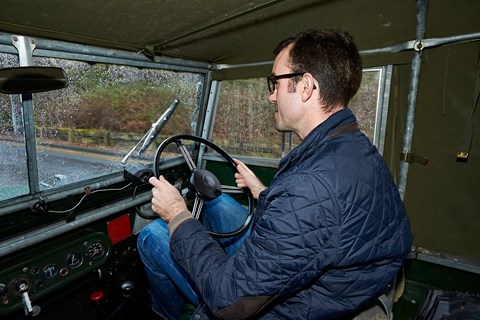► Driving one of the earliest Land Rovers
► We take a 1949 Series 1 off-road
► Early DNA intact in contemporary Defender
After a visit to the new Land Rover Defender Celebration Line at the Solihull factory – a period museum tour designed to mark the retirement of the iconic 4×4 – my historical education took a turn for the better when someone tossed me the key to one of the very oldest models the company owns on its heritage fleet: a 1949 Series 1.
Registration 437 DEL is one of the earliest Series 1 cars and is kept in stunning concours condition by Land Rover. It’s the same car that appeared on Top Gear last night, Richard Hammond driving it across the beach in his tribute to the Defender.
The Shadow factory in Birmingham only started making off-roaders a year before this one was built, so it was all the more impressive that I was let loose on the factory’s sadistic Jungle Track off-road course in what other brands may consider a 66-year-old museum piece.
Driving a 1949 Land Rover Series 1 around the Jungle Track
As with many old cars, the first Series 1 is a diminutive slip of a car. The light, tinny doors swing open to reveal a snug, sparse two-seater cabin seemingly held together by tubes of scaffolding. The cross member across the dash stretches like a towel rail – ‘the Jesus rail’ to grab, my guide dubs it. Ahead of me the split-windscreen is virtually upright, giving a great view ahead and I flick on the single wiper in an attempt to clear the grey February drizzle.
Impressively, the canvas roll-top remains watertight throughout, shielding photographer James (stuck in the loadbay behind) and me from the elements. And the Series 1 is indeed in its element as we set off from the Land Rover Experience centre in Solihull for the same off-road course around which a few minutes earlier I’d driven a contemporary Defender 110.
The two book-ends of the Defender family share more than you might think. In fact, two parts are carried over between the earliest Land Rovers and a contemporary Defender – a seat brace under the rear bench and a lashing point for canvas hoods – but it’s as much a spiritual connection as an engineering one. The Land Rover genes are strong in the original and continue to this day.
Defenders and Series 1s: a shared lineage
Today’s Defender has a compromised driving position, too; fine for a short pootle around an off-road course, less good for an M-way schlepp. Nor is the Series 1 geared up to adjust for different size drivers, but I fit in comfortably enough and can operate all the controls so I don’t spear a priceless historical relic into the undergrowth. You gotta love the thin, spindly wheel that tells you just what’s going on at the front axle. A modern Landie’s rim is all chunky and fat and airbagged to the hilt.

As we trundle out of the car park, it’s immediately apparent that the Series 1 has a woeful turning circle, and I end up sawing at the slender wheel every time we do a sharp turn. The same trait manifests itself in a Defender as you pull into a parking bay… you get the idea.
Forget the road manners. How is the Series 1 off road?
Judging any 1949 car by contemporary standards is a fruitless exercise. The four-speed gearbox is stubborn and lacks synchromesh in first, and I frequently stumble into the wrong cog of four. We don’t really go fast enough to test the brakes, but I’m more interested in what the Series 1 does off-road than on.
At a standstill, I tug a lever by my left foot to select low range. And there’s a special rigmarole of pulling an O-ring from the floor to lock the car into four-wheel drive, as the Series 1 only drives both axles under power, reverting to 2wd when coasting. Not ideal when descending some of the tough inclines we’re about to negotiate.
Set up accordingly, the 1949 Landie just goes and goes and goes. Bereft of electronic nannies or hill descent controls, this is all about line, approach and careful pedal prodding. It feels lighter than the 1200kg claim; it’s nimble and chugs up the same ups and downs as the modern 110 did quarter of an hour earlier. A bit of a run-up to counter the lack of torque (the 1.6 four-pot musters a scant 50bhp and 85lb ft on a good day) and the Series 1 is unstoppable.
With leaf springs, it’s important not to go too fast when the going gets bumpy off-road, as the resulting pogoing hinders traction. But the raised ground clearance, unflappable grip and commanding view out – all improbable angles and at-one-with-nature connection – is unmistakable. This is Land Rover distilled and it’s a timely reminder our motorscape will be the poorer when the Defender ceases UK production in December.
Anyone can tour the Land Rover Defender production line; tickets cost from £45 per person – and if you dig deeper, you could drive the heritage Land Rovers including 437 DEL, too. Call +44 (0)121 700 4619 for more information.